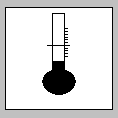| Butter | [German version] |
Table of contents |
|
| General: | ||
| Product information | ||
| Packaging | ||
| Transport | ||
| Container transport | ||
| Cargo securing | ||
Product information
Product name
| German | Butter |
| English | Butter |
| French | Beurre |
| Spanish | Mantequilla |
| CN/HS number * | 0405 10 ff. |
(* EU Combined Nomenclature/Harmonized System)
Product description
Butter, a dairy product, is a water-in-fat emulsion. It is considered a high grade edible fat and is normally yellow in color.
The history of butter reaches back into antiquity. It is assumed that butter has been made ever since humans started drinking milk. For example, butter was used as a food in ancient Persia and Egypt.
The butter production process may in brief be divided into the following stages:
| separation of the cream from the milk by leaving it to stand or spinning it in a centrifuge, | |
| pasteurization at above 90°C to reduce the activity of enzymes and microorganisms, | |
| beating the cooled cream in a butter churn or buttermaking machine (churning), | |
| kneading and shaping of the butter, | |
| packaging. |
Chemically speaking, butter consists of the following constituents:
| fats approx. 82% | |
| water approx. 16% | |
| nonfat milk components approx. 2% |
The main constituents of butter are glycerol and fatty acids.
Butter is transported in either chilled or frozen form. The advantages of transport in frozen form are, firstly, a longer storage life and, secondly, greater stackability of the product. These advantages are counterbalanced by the greater refrigeration capacity required throughout the transport chain.
In Germany, butter is primarily made from sour cream with added lactic acid bacteria, a practice which considerably accelerates separation of the cream and moreover ensures a better churning result than when butter is made from sweet, fresh cream. Butter is offered for sale in either salted or unsalted form.
Quality / Duration of storage
Butter is graded by being classed in certain commercial categories. The highest quality butter is known in Germany as „Deutsche Markenbutter“.
The most important quality changes are:
| Rancidity: Butter primarily tends to become rancid due to the action of atmospheric oxygen, light, heat, water, metals, enzymes (lipases) and microorganisms. When butter becomes rancid it breaks down into glycerol and fatty acids. Due to its high water content, the size of the water droplets in the water-in-oil emulsion being < 6 µm, butter is subject to rapid microbiological spoilage at normal temperatures. Since the droplets are isolated one from the other, microbial growth occurs within individual droplets and if these are very small, multiplication cannot even occur. If the droplets are > 6 µm, the contact area with the fat rises sharply as the size of the droplets increases. These factors still operate at temperatures of -12°C and the microbes are inactivated only once the temperature falls below this value. Rancid butter becomes yellow to brown and the flavor becomes harsh. | |
| Souring: Bacteria, mold, water, air, light, enzymes and some metals can accelerate souring. Souring results in the formation of free fatty acids, such as butyric acid and caproic acid, and the butter becomes soapy in flavor. | |
| Tallowiness: Tallowiness is caused by the increase in melting point under the action of water, atmospheric oxygen and light. An unpleasant, tallowy flavor is the result. Packaging must therefore be made opaque and airtight. | |
| Edge yellowing: Evaporation of water results in a darker yellow color on the blocks of butter, starting from the edges. |
Butter should not have an oily, sour, tallowy, fishy or rancid flavor. The yellow color is the result of its carotene content. Butter must be readily spreadable and must not be hard, crumbly, greasy or unctuous.
Butter which has already melted can be recognized from the dark streaks (water marks) and must be rejected.
The maximum duration of storage for chilled and frozen butter is stated in [1] as follows:
| Temperature | Relative humidity | Max. duration of storage | Source |
| -1 – +4°C | 75 – 80% | 1 – 2 months | [1] |
| -10°C | 80 – 85% | 3 months | [1] |
| -15°C | 80 – 85% | 4 – 6 months | [1] |
| -23 – -18°C | 80 – 85% | 8 – 12 months | [1] |
Intended use
Butter is primarily used as a foodstuff (spread). It is a high-quality edible fat.
Figure
(Click on the Figure to enlarge it.)
Figure 1 |
Countries of origin
This Table shows only a selection of the most important countries of origin and should not be thought of as exhaustive.
| Europe | Finland, Sweden, Denmark, Germany, Netherlands, Belgium, France, Ireland, England, Romania, Czech Republic |
| Africa | |
| Asia | |
| America | Canada, USA, Argentina |
| Australia | Australia, New Zealand |
Back to beginning
Packaging
Butter is packaged either as a bulk block (wrapped in waxed paper) of a net weight of 25 kg or as blocks (wrapped in waxed paper or aluminum foil) of a net weight of 250 g. The waxed paper and aluminum foil act as opaque and airtight packaging materials in order to protect the butter from reduction in quality. The small packages are consolidated in hard board cartons containing approx. 40 units. The packaging size is so selected that the dimensions of the individual area modules or area module multiples are conformed to the conventional pallet sizes (800×1200 mm and 1000×1200 mm) and cargo units may thus be produced.
| Marking of packages | ||
 Keep dry |
 Keep away from heat (solar radiation) |
|
Back to beginning
Transport
Symbols
 General cargo |
 Temperature-controlled |
Means of transport
Ship, truck, railroad
Container transport
Refrigerated containers
Cargo handling
Since butter is highly impact- and pressure-sensitive, appropriate care must be taken during cargo handling.
It is also imperative that the goods be protected from moisture (rain, snow) during cargo handling and from excessively high temperatures. It is absolutely essential to comply with the specified refrigeration temperature.
Stowage factor
| 1.50 m³/t (cartons) [1] | |
| 1.34 – 1.39 m³/t (cartons) [11] |
Stowage space requirements
Cool, dry
Segregation
Synthetic fiber rope, thin fiber nets, matting, jute coverings
Cargo securing
Because of its considerable impact- and pressure-sensitivity, packages of this cargo must be secured in such a way that they are prevented from damaging each other. Spaces between packages or pallets must be filled, to prevent slippage or tipping. By selecting the correct packaging size or cargo unit (area module or area module multiple), holds can be tightly loaded (without spaces).
Back to beginning
Risk factors and loss prevention
RF Temperature
Butter requires particular temperature, humidity/moisture and ventilation conditions (SC VII) (storage climate conditions).
A written cooling order must be obtained from the consignor before loading is begun. This order must always be complied with during the entire transport chain.
Due to its high water content butter is subject to rapid microbiological spoilage at normal temperatures
Butter may be transported either frozen or chilled. The following Tables merely constitute a rough estimate of appropriate temperature ranges. Temperatures may deviate from these values, depending on the particular transport conditions.
Frozen butter:
| Designation | Temperature range | Source |
|---|---|---|
| Travel temperature (favorable temperature range) | -16 – -18°C | [2] |
Butter must be flash-frozen to protect it from losses in quality. The rapid cooling results in the formation of only small ice crystals, which have no negative effects. If, however, the temperature is reduced very slowly, relatively large ice crystals are formed which can result in losses of quality (crumbly texture).
Chilled butter:
| Designation | Temperature range | Source |
|---|---|---|
| Loading temperature | 4°C | [1] |
| Travel temperature (favorable temperature range) | 1 – 4°C | [1] |
The melting point of butter is 20 – 25°C.
At temperatures of above 8°C, distortion of the product may occur.
At temperatures below 0°C, losses in quality (crumbly texture) may occur due to excessively slow cooling of the butter.
Back to beginning
RF Humidity/Moisture
Butter requires particular temperature, humidity/moisture and ventilation conditions (SC VII) (storage climate conditions).
| Designation | Humidity/water content | Source |
| Relative humidity | 75 – 80% | [1] |
| Water content | 19 – 24% | [1] |
| 16% | [10] | |
| Maximum equilibrium moisture content | 75% | [1] |
The cartons must be protected from all forms of moisture (seawater, rain and condensation water) and from excessive humidity levels. Typical patterns of moisture damage to a cargo are as follows:
| loose, mildewed, unattractive labels | |
| mold on and in cartons | |
| crushed cartons, due to moisture penetration, leakage, total loss |
Back to beginning
RF Ventilation
Butter requires particular temperature, humidity/moisture and ventilation conditions (SC VII) (storage climate conditions).
Recommended ventilation conditions: circulating air, 15 – 20 circulations/hour without supply of fresh air in order to ensure uniform cooling of the cargo in the hold.
Fresh air should not be supplied in order to avoid any possible increase in temperature and the introduction of microorganisms into the holds.
Back to beginning
RF Biotic activity
Butter displays 3rd order biotic activity.
It belongs to the class of goods in which respiration processes are suspended, but in which biochemical, microbial and other decomposition processes still proceed.
Back to beginning
RF Gases
No risk.
Back to beginning
RF Self-heating / Spontaneous combustion
No risk.
Back to beginning
RF Odor
| Active behavior | Butter has a very slight, pleasant odor. If the butter is stored at excessive temperatures or in direct contact with atmospheric oxygen, it becomes rancid and smalls unpleasant. |
| Passive behavior | Butter is highly sensitive to foreign odors. It must therefore not be stored together with fish, cheese and citrus fruit. Where possible, butter should also not be stowed together with meat and other types of fruit. Freshly sawn lumber must not be used for packaging boxes. |
Back to beginning
RF Contamination
| Active behavior | Butter causes contamination due to its fatty consistency. |
| Passive behavior | Butter is sensitive to dust, dirt and other fats/oils. |
Back to beginning
RF Mechanical influences
Butter is sensitive to pressure and impact loads. Improper handling or stowage may result in damage. Unlike chilled butter, frozen butter is relatively insensitive to such loads.
The packages must be secured appropriately in the hold or container so that they cannot move during transport. In the case of container transport, it is also important for the goods to be secured in the door area so that they cannot fall out of the container when the doors are opened.
Back to beginning
RF Toxicity / Hazards to health
No risk.
Back to beginning
RF Shrinkage/Shortage
Loss of volume may be caused by breakage or theft.
Back to beginning
RF Insect infestation / Diseases
No risk.
Back to beginning
